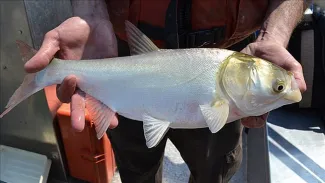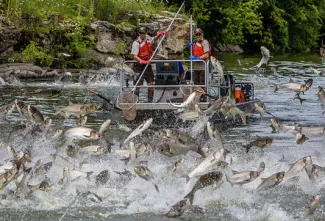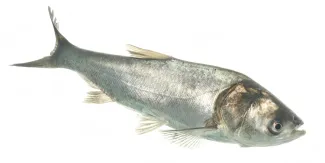Introduction
The silver carp is native to the large rivers of eastern China and looks and acts very similar to the bighead carp. They were imported into Arkansas in 1973 for use as phytoplankton control in culture ponds and as a potential food fish. By 1980 the species was discovered in natural waters, probably a result of escapes from fish hatcheries and other types of aquaculture facilities.
Status and Impacts
Silver carp have been found in Red River and tributaries in Oklahoma.
In numbers, the silver carp has the potential to cause enormous damage to native species because they feed on plankton required by larval fish and native mussels. They are efficient at straining suspended material from the water through use of gill rakers that are fused into sponge-like porous plates. Silver carp are a competitor with all larval and juvenile fishes as well as adult paddlefish, bigmouth buffalo, and gizzard shad. Population densities in the Mississippi River have exploded and native fish species have been displaced. Silver carp have spread throughout the large rivers in the Mississippi basin and are reproducing in off-channel and backwater habitats.
Small silver carp and bighead carp resemble gizzard shad. Cast-netting for bait in tailwaters below some major reservoirs in Oklahoma has the potential to introduce invasive carp into some of the premier sportfishing lakes in the state. Anglers routinely cast net for bait below the Texoma Dam and use the bait to fish for striped bass or catfish in Lake Texoma. Invasive carp can be accidentally introduced into the lake through this practice. Bighead and silver carp have reproductive requirements like those of striped bass. There is a real potential to establish a reproducing population of invasive carp in Lake Texoma which could be devastating to striped bass fishery and paddlefish recovery efforts.
Key Identification
- Deep-bodied fish that is laterally compressed (narrow)
- Sharply keeled belly from the anal fin to the throat
- Smaller head and mouth than the bighead carp
- Very tiny scales on their body, head and gill covers are scale-less
- Eyes are situated far forward near the middle of their head and slightly turned down
What can you do to help stop the spread of invasive carp?
- Consult local conservation authorities about laws and regulations governing importation, culture and stocking
- Ask your bait dealer where their baitfish came from and never release any unused baitfish to the wild
- Never release pet fish, bait fish, or aquatic organisms from the home aquarium to public water


